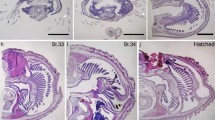Summary
The protonephridial terminal organ in the nemertean Pantinonemertes californiensis is composed of two cells that are similar in size and shape and are mirror images of each other. Basally in the organ the two cells combine to form a binucleate cytoplasmic mass. Apically they are intimately joined to form a subcylindrical thin-walled weir apparatus; this part is supported by two opposed cytoplasmic columns running the length of the weir region, one originating from each of the two cells, and by a number of regularly spaced circular bars that arise from the two columns. The ciliary flame consists of 94–114 cilia that originate in the bases of the two cells, and it is surrounded by a palisade of incomplete circlets of long, straight microvilli. The convoluted protonephridial tubule is rich in structures that indicate intensive reabsorption from the primary urine. It is argued that the terminal organs in Pantinonemertes and Geonemertes are fundamentally similar and differ only in the amount of microtubules present in the longitudinal supports.
Similar content being viewed by others
Abbreviations
- BL :
-
basal lamina
- CF :
-
ciliary flame
- CT :
-
connective tissue
- CV :
-
coated vesicle
- E :
-
endocytotic pit
- FM :
-
filtration membrane
- G :
-
Golgi complex
- LC :
-
longitudinal cytoplasmic column
- M :
-
mitochondrion
- MT :
-
microtubules
- MV :
-
microvilli
- N :
-
nucleus
- NPC :
-
nucleus of protonephridial capillary cell
- PC :
-
protonephridial capillary cell
- R :
-
rootlets
- TB :
-
transverse bar
- TC :
-
terminal cell
- WE :
-
weir, exterior of fenestrated wall
- WI :
-
weir, interior of same
References
Coe WR (1929) The excretory organs of terrestrial nemerteans. Biol Bull 56:306–311
Coe WR (1930) Unusual types of nephridia in nemerteans. Biol Bull 58:203–216
Gibson R, Moore J, Crandall FB (1982) A new semi-terrestrial nemertean from California. J Zool London 196:463–474
Hett ML (1927) On some land nemerteans from Upolu Island (Samoa), with notes on the genus Geonemertes. Proc Zool Soc London 1927:987–997
Jespersen Å (1987) Ultrastructure of the protonephridium in Acteonemertes bathamae Pantin (Rhynchocoela:Enopla:Hoplonemertini). Acta Zool Stockholm 68:115–125
Kalt MR, Tandler B (1971) A study of early amphibian embryos for electron microscopy. J Ultrastruct Res 36:633–645
Moore J (1985) The distribution and evolution of terrestrial nemertines. Am Zool 25:15–21
Moore J, Gibson R (1981) The Geonemertes problem (Nemertea). J Zool London 194:175–201
Moore J, Gibson R (1985) The evolution and comparative physiology of terrestrial and freshwater nemerteans. Biol Rev 60:257–312
Pantin CFA (1961) Acteonemertes bathamae, gen. et sp. nov. An upper littoral nemertine from Portobello, New Zealand. Proc Linn Soc Lond 172:153–155
Pantin CFA (1969) The genus Geonemertes. Bull Br Mus Nat Hist Zool 18:263–310
Author information
Authors and Affiliations
Rights and permissions
About this article
Cite this article
Jespersen, Å., Lützen, J. The fine structure of the protonephridial system in the land nemertean Pantinonemertes californiensis (Rhynchocoela, Enopla, Hoplonemertini). Zoomorphology 108, 69–75 (1988). https://doi.org/10.1007/BF00539782
Received:
Issue Date:
DOI: https://doi.org/10.1007/BF00539782




